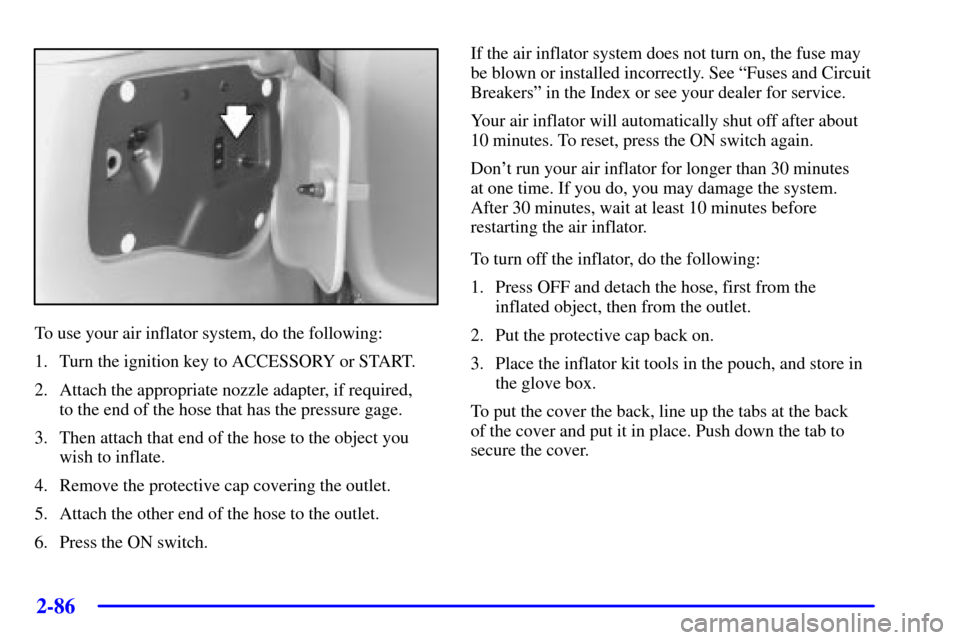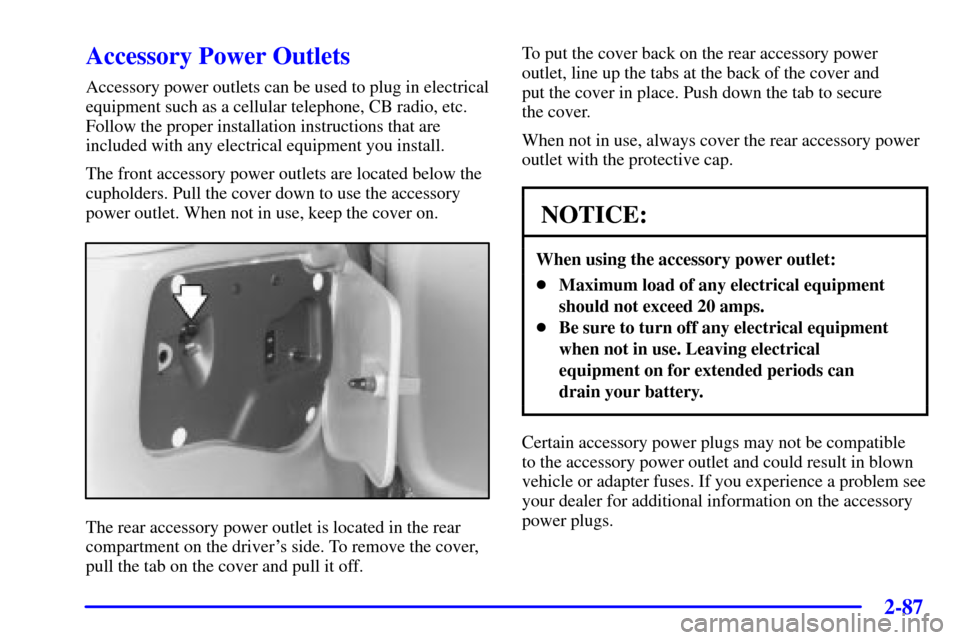Page 167 of 436
2-75
5. Add one peg at a time until your garage door opener
operates with the compartment door closed when
you press the button.
Storage Bin
At the base of the center instrument panel console,
there is a storage bin. To open the bin, lift the latch
release and the door will fold down.
Inside the bin, you will find a tray that slides out.
Slide the tray all the way toward the rear of the vehicle
until the tray locks onto the plastic tabs at the end of the
guide rails. The tray can hold CDs or cassettes in the
center area. You can also store cassettes in the left and
right side area. The tray can be removed for cleaning
or when you want to replace the selection of CDs or
cassettes. Slide the tray back into the storage bin before
closing the bin door. The tray can also be placed in the
glove box for locked storage if desired.
Page 168 of 436
2-76
Removing and Replacing the TrayTo remove the tray, slide it almost all the way out.
Don't let the tray lock over the plastic tabs at the end
of the guide rails (A). Lift the tray out of the guide rails.
The rubber mat under the tray also lifts out for cleaning.
When the rubber mat is put back in, be sure the tabs at
the back of the mat are seated in the slots at the back of
the storage bin.
The dividers in the tray can be removed by squeezing
the plastic tabs on the bottom of the dividers, while
pulling up. Put the dividers back in by sliding them
down until the tabs click into place.
To reinstall the tray, line up the guides on the bottom
of the tray with the guide rails in the storage bin door.
Slide the tray back in.
Page 178 of 436

2-86
To use your air inflator system, do the following:
1. Turn the ignition key to ACCESSORY or START.
2. Attach the appropriate nozzle adapter, if required,
to the end of the hose that has the pressure gage.
3. Then attach that end of the hose to the object you
wish to inflate.
4. Remove the protective cap covering the outlet.
5. Attach the other end of the hose to the outlet.
6. Press the ON switch.If the air inflator system does not turn on, the fuse may
be blown or installed incorrectly. See ªFuses and Circuit
Breakersº in the Index or see your dealer for service.
Your air inflator will automatically shut off after about
10 minutes. To reset, press the ON switch again.
Don't run your air inflator for longer than 30 minutes
at one time. If you do, you may damage the system.
After 30 minutes, wait at least 10 minutes before
restarting the air inflator.
To turn off the inflator, do the following:
1. Press OFF and detach the hose, first from the
inflated object, then from the outlet.
2. Put the protective cap back on.
3. Place the inflator kit tools in the pouch, and store in
the glove box.
To put the cover the back, line up the tabs at the back
of the cover and put it in place. Push down the tab to
secure the cover.
Page 179 of 436

2-87
Accessory Power Outlets
Accessory power outlets can be used to plug in electrical
equipment such as a cellular telephone, CB radio, etc.
Follow the proper installation instructions that are
included with any electrical equipment you install.
The front accessory power outlets are located below the
cupholders. Pull the cover down to use the accessory
power outlet. When not in use, keep the cover on.
The rear accessory power outlet is located in the rear
compartment on the driver's side. To remove the cover,
pull the tab on the cover and pull it off.To put the cover back on the rear accessory power
outlet, line up the tabs at the back of the cover and
put the cover in place. Push down the tab to secure
the cover.
When not in use, always cover the rear accessory power
outlet with the protective cap.
NOTICE:
When using the accessory power outlet:
�Maximum load of any electrical equipment
should not exceed 20 amps.
�Be sure to turn off any electrical equipment
when not in use. Leaving electrical
equipment on for extended periods can
drain your battery.
Certain accessory power plugs may not be compatible
to the accessory power outlet and could result in blown
vehicle or adapter fuses. If you experience a problem see
your dealer for additional information on the accessory
power plugs.
Page 209 of 436

2-117
Manual Compass Calibration
If the compass appears erratic and the calibration
symbol does not appear, you must manually put
the compass into the calibration mode.
Turn the ignition on and cycle the DIC to the
compass/temperature mode. Press both the E/M and
MODE buttons simultaneously for at least 10 seconds
until the calibration symbol appears. Release both
buttons and complete three 360� turns in an area free
from large metal objects. The calibration symbol will
turn off and the compass reading will be displayed.
Error Displays
�An error of the vehicle's speed sensor or fuel sender
will cause
-E- to be displayed.
�In the absence of vehicle communications, a double
dash ª
--º is displayed.
If one of these error messages appear, see your dealer.
Trip Computer
There are five trip computer displays which may be
stepped through by pushing the MODE button.
The information will appear in the following order:
�AVG ECON (Average Fuel Economy): This shows
the average fuel economy since the last reset.
�INST ECON (Instantaneous Fuel Economy):
This shows fuel economy for the most recent second
of driving.
�RANGE (Trip Range): This shows the estimated
distance that can be traveled with the remaining fuel.
The fuel economy used to calculate range is based on
the last few hours of driving.
�FUEL USED (Trip Fuel Used): This shows the
accumulated fuel used since the last reset.
�AVG SPEED (Average Speed): This shows the
average speed since the last reset.
Page 264 of 436

4-7
Avoid needless heavy braking. Some people drive
in spurts
-- heavy acceleration followed by heavy
braking
-- rather than keeping pace with traffic.
This is a mistake. Your brakes may not have time to
cool between hard stops. Your brakes will wear out
much faster if you do a lot of heavy braking. If you
keep pace with the traffic and allow realistic following
distances, you will eliminate a lot of unnecessary
braking. That means better braking and longer
brake life.
If your engine ever stops while you're driving, brake
normally but don't pump your brakes. If you do, the
pedal may get harder to push down. If your engine
stops, you will still have some power brake assist.
But you will use it when you brake. Once the power
assist is used up, it may take longer to stop and the
brake pedal will be harder to push.
Anti-Lock Brakes (ABS)
Your vehicle has anti-lock brakes (ABS). ABS is an
advanced electronic braking system that will help
prevent a braking skid.
When you start your engine, or when you begin to
drive away, your anti
-lock brake system will check
itself. You may hear a momentary motor or clicking
noise while this test is going on, and you may even
notice that your brake pedal moves or pulses a little.
This is normal.
If there's a problem with
the anti
-lock brake system,
this warning light will stay
on. See ªAnti
-Lock Brake
System Warning Lightº
in the Index.
Page 265 of 436
4-8
Here's how anti-lock works. Let's say the road is wet.
You're driving safely. Suddenly an animal jumps out in
front of you.
You slam on the brakes and continue braking.
Here's what happens with ABS.
A computer senses that wheels are slowing down. If one
of the wheels is about to stop rolling, the computer will
separately work the brakes at each wheel.The anti
-lock system can change the brake
pressure faster than any driver could. The computer is
programmed to make the most of available tire and road
conditions. This can help you steer around the obstacle
while braking hard.
As you brake, your computer keeps receiving updates on
wheel speed and controls braking pressure accordingly.
Page 272 of 436

4-15
Loss of Control
Let's review what driving experts say about what happens
when the three control systems (brakes, steering and
acceleration) don't have enough friction where the tires
meet the road to do what the driver has asked.
In any emergency, don't give up. Keep trying to steer and
constantly seek an escape route or area of less danger.
Skidding
In a skid, a driver can lose control of the vehicle. Defensive
drivers avoid most skids by taking reasonable care suited
to existing conditions, and by not ªoverdrivingº those
conditions. But skids are always possible.
The three types of skids correspond to your vehicle's
three control systems. In the braking skid, your wheels
aren't rolling. In the steering or cornering skid, too
much speed or steering in a curve causes tires to slip and
lose cornering force. And in the acceleration skid, too
much throttle causes the driving wheels to spin.
A cornering skid is best handled by easing your foot off
the accelerator pedal. If you have the ªTraction Control
System,º remember: It helps avoid only the acceleration
skid. If you do not have this system, or if the system is
off, then an acceleration skid is also best handled by
easing your foot off the accelerator pedal.If your vehicle starts to slide, ease your foot off the
accelerator pedal and quickly steer the way you want
the vehicle to go. If you start steering quickly enough,
your vehicle may straighten out. Always be ready for a
second skid if it occurs.
Of course, traction is reduced when water, snow, ice,
gravel or other material is on the road. For safety,
you'll want to slow down and adjust your driving to
these conditions. It is important to slow down on
slippery surfaces because stopping distance will be
longer and vehicle control more limited.
While driving on a surface with reduced traction, try
your best to avoid sudden steering, acceleration or
braking (including engine braking by shifting to a
lower gear). Any sudden changes could cause the tires
to slide. You may not realize the surface is slippery until
your vehicle is skidding. Learn to recognize warning
clues
-- such as enough water, ice or packed snow on
the road to make a ªmirrored surfaceº
-- and slow
down when you have any doubt.
Remember: Any anti
-lock brake system (ABS) helps
avoid only the braking skid.